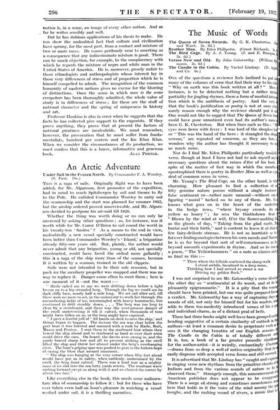An Arctic Adventure
Under Sail in the Frozen North. By Commander F. A. Worsley. (S. Paul. 18s.) Tuts is a saga of sails. Originally flight was to have been added, for Mr. Algarsson, first promoter of the expedition, had in mind to reach Spitzbergen by sail and thence to fly to the Pole. He enlisted Commander Worsley to carry out the seamanship and the start was planned for summer 1925, but the airship ordered proved unserviceable, and Mr. Algars- son decided to postpone his air-raid till 1926.
Whether the thing was worth doing or no can only be answered by asking other questions ; as, for instance, was it worth while for Mr. Conor O'Brien to sail round the world in his twenty-ton Saoirse ? As a means to the end in view, undoubtedly a new vessel specially constructed would have been better than Commander Worsley's ' Island,' a brigantine already fifty-one years old. But, plainly, the author would never admit that any brigantine, young or old, not specially constructed, could have faced the ordeal more gallantly ; this is a saga of the ship more than of the seamen, because it is written by a seaman, trained in the old clippers.
Sails were not intended to be their sole resource, but in pack ice the auxiliary propeller was snapped and there was no way to replace it. Danger came often to meet them ; here is one moment of it—not the worst :—
" Berle- called me to say we were drifting down before a light breeze on to a big stranded berg. Through the fog we could see its dark cliffy base, nearly half a:mile long. We set sail after sail, till there were no more to set, in the endeavour to work her through the encumbering fields of ice; intermingled with heavy hummocks, but continued to drift steadily down. . . . The berg was too long to clear by a sternbOard, and there was the ever-present danger of the swell undercutting it till it calved,-when thousands of tons might have fallen on us, or the berg might have capsized.
" I gave a fearful yell of ' All hands on deck to save the ship,' and things began to happen. Tho instant the sea was clear below the port boat it was lowered and manned with a rush by Hark:, Burt, Mason and Fenton. I sent them to the starboard bow where they towed the ship ahead and to starboard as hard as ever their arms could drive the oars. On board, the davits were swung in, and the yards braced sharp fore and aft to prevent striking as the swell lifted the ship and threw her almost under the berg's overhanging crest.. The boat's griping spar was pushed to port in the forlorn hope of easing the blow that seemed imminent-.
" The ship was hanging at the very corner when fifty feet ahead
would have put us in safety, when suddenly, undermined by the swell, the berg front calved. There was a loud roar as a mighty mass of ice slid into the sea forty yards astern. The resultant wave rushing forward swept us along with it-and we cleared the corner by about two feet."
Like everything else in the book, this needs some rudimen- tary idea of seamanship to follow it ; but for those who have ever taken even half an hour's pleasure in watching a vessel worked under sail, it is a thrilling narrative.














































 Previous page
Previous page